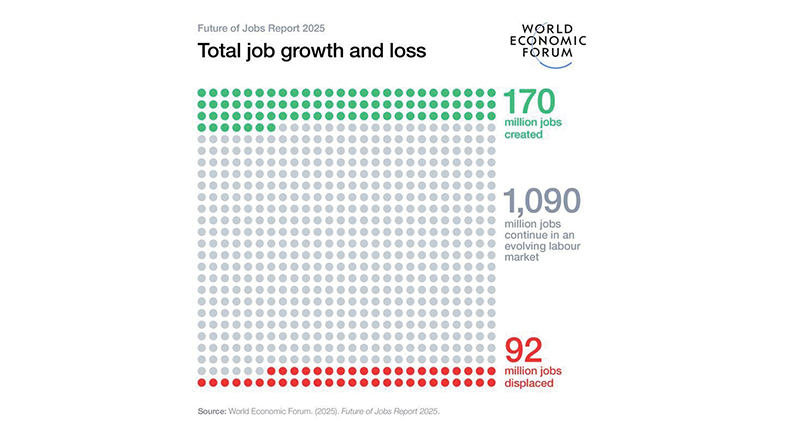Only the nimble survive
-
- from Shaastra :: vol 01 edition 02 :: Jul - Aug 2021
How organisations respond to disruptive technology change will determine their standing in a post-COVID world.

One of the positive side-effects of the COVID crisis has been a rapid acceleration in the adoption of digital technologies across sectors. People's behaviours have also changed significantly with more than a year of remote working and learning. Several important questions arise. How many of these changes in behaviours are permanent? How fast will the digital transformation proceed? Will businesses be able to respond and leverage the new opportunities adequately? While it is still too early to have definitive answers to these questions, understanding a simple framework for the transformational impact of technology may be useful.
When a new technology arrives, the first-order impact of the new technology is substitution of the old technology by the new. For example, when the automobile was invented, people replaced travelling by horse carriages with travelling by car. Similarly, when the cellphone was invented, people replaced fixed-line calls with cellphone calls.
The second-order impact of new technology is diffusion. This happens because usually the new technology is better, cheaper and more effective, and so more and more people start using it. We saw this with the increased adoption of cars and cellphones a few years after their invention.
The final and third-order impact of new technology is transformation – when the ways in which people live and work get fundamentally changed due to the widespread adoption of the new technology. To continue with the car example, shopping malls and suburbs came up in many developed economies because families could drive to shop or commute from home to their workplace. Similarly, cellphones have changed many aspects of the way we live and work in society. Few of these far-reaching changes could have been predicted when the technologies were invented.
With the COVID crisis, we have seen a rapid acceleration in the substitution and diffusion phases in the context of the above framework. For example, remote learning replaced (substitution) in-person learning in schools and colleges around the world (diffusion) for months. What we have not yet seen is the full transformational impact of this digital acceleration.
DISRUPTIVE TECHNOLOGY
One of the subjects I discuss with students is how organisations respond to disruptive change, especially disruptions caused by technology. The short answer: in general, poorly. Clayton Christensen was one of the first business researchers to point out that industry leadership changed each time there was a disruptive change in the underlying technology.
Christiansen explained this brilliantly in The Innovator's Dilemma. The core insight of his book was that industry leaders usually resisted investing in disruptive technologies; instead, they allocated resources to current clients who demanded increasingly sophisticated features in products based on the current technology. As a result, incumbent leaders failed to make investments in new disruptive technology – but new challengers adopted and developed it aggressively. When the new disruptive technology became mature for large-scale adoption, customers shifted to the challengers, who had the best expertise in the new technology. The erstwhile leaders lost their leadership as they could not meet customers' needs with the new disruptive technology. Industry leadership shifted from the incumbent to the challenger.
Incumbent corporate leaders typically fail to make investments in new disruptive technology, but challengers adopt it aggressively - and go on to win leadership.
Companies typically respond to the challenge of disruptive technology changes in two ways: inside-out innovation and outside-in innovation. Inside-out innovation refers to approaches that seek to foster disruptive new ideas from within the organisation – usually by promoting innovation and entrepreneurship within the corporation. Many firms also set up internal venture capital funds to fund new start-up ideas by employees.
In contrast, outside-in approaches rely upon forming partnerships with, learning from and acquiring external companies, usually start-ups with disruptive new ideas. Cisco was one of the first tech companies to change its corporate innovation strategy from internal R&D to external R&D acquisition through mergers and acquisitions. In recent times, this focus on learning and innovating from the outside has been accepted as the fastest and most reliable way to bring disruptive new products and technologies into the organisation.
LOOKING BEYOND
If we can learn from other industry sectors that have gone through this disruption process, one insight is important: we will not succeed in innovating at a fast-enough pace to leverage all the new possibilities if we only focus on innovating from the inside. We have to look outside our organisations for disruptive and innovative business models. We have to look at innovative start-ups that are creating learning models with new technologies, and we have to partner with technology leaders to create new learning partnerships. We have to launch new innovative models and experiment and learn in rapid cycles. We have to resist the pressures to continue to invest solely in current business lines and existing customer segments. We have to venture into new products and customer segments that may look very different initially from our current business profile. Doing this will not be easy, and there will be significant cultural barriers to overcome.
Outside-in innovation is the way of the future for true business transformation. The sooner you adopt this mantra and excel at it, the higher your chances of thriving as a leader in the face of technological disruptions.

@soumitradutta
Have a
story idea?
Tell us.
Do you have a recent research paper or an idea for a science/technology-themed article that you'd like to tell us about?
GET IN TOUCH














